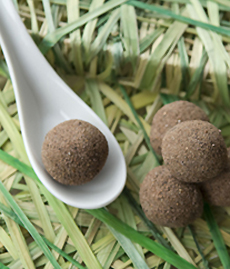
Chocolate truffles made with raw cacao, from Uli Mana, a NIBBLE Top Pick Of The Week. Photo by Corey Lugg | THE NIBBLE.
Last Updated May 2018 |
Product Reviews / Main Nibbles / ChocolateChocolate GlossaryChocolate Terms & Definitions: R
Here you’ll find terms including raw cacao, Rio Caribe cacao and rustic chocolate. If you think we should consider chocolate terms and definitions other than those we have provided click on the Contact Us link on this page. Also enjoy our many other other food glossaries. Click on the letters below to visit other pages. a b c d e f g h i j k l m n o p q r s t u v w x y z This glossary is protected by copyright and cannot be reproduced in whole or part. RAW CACAO or RAW CHOCOLATERaw cacao has two meanings. First, it refers to the harvested, fermented and dried cacao beans. They are hand-sorted, graded, packed into jute bags at the farm and ready for sale and processing (as with coffee, each chocolate manufacturer roasts the beans according to its preferences). The bags weigh about 139 pounds (62.54 kg). The second meaning refers to the raw food movement, which does not process food at temperatures higher than 118°F, in order to preserve the nutrients. Here, the beans are barely heated, ripening some of the flavors but leaving the taste of raw (unroasted) cacao beans. Foods produced at low temperatures are said to preserve the nutrients; the beans are not roasted traditionally are processed at 118°F and below. No dairy is used. See Uli Mana Raw Cacao, a NIBBLE Top Pick Of The Week. RIO CARIBEA Trinitario bean grown near the Rio Caribe, in the Sucre State of Venezuela. This cacao has a slight dark tone and a refreshing bitterness. Common flavors are coffee, almonds, slight red fruits, and pure cocoa. ROAST, LIGHTSome brands opt to roast cacao beans for a shorter time. This light roast imparts a sharp, fruity tone to the finished chocolate. ROAST, DARKA dark roast indicates that the beans have been roasted longer to further mellow the cacao’s flavor. As a result, flavors tend to have “dark” tones with traces of caramel, woods, and coffee. ROASTINGThe first step in producing chocolate from cacao beans. Similar to roasting coffee, the heating process fully develops the chocolate flavors and aromas of the cacao beans. Roasting times vary by producer, but a typical roasting time is 30 minutes. After roasting, the nibs go to the grinding room to be ground. ROCHERIn French, rocher is a rock. In chocolate, rochers are slivered almonds, coated in chocolate to create clusters that are poetic chocolate “rocks.” RUSTIC CHOCOLATEIn positive terms, “rustic” chocolate refers to a pre-industrial style of chocolate, before conching was invented. Beans were minimally processed and less refined sugar was used. The texture was rougher and crunchier. Today artisans like Italy’s Claudio Corallo choose to make chocolate in the old style. However, chocolate that was not intended to be made in such fashion, but which has an inferior texture and mouthfeel, can be termed “rustic.”
Continue To Next Page: Terms With S
Lifestyle Direct, Inc. All rights reserved. Images are the copyright of their respective owners.
|
Last Updated May 2018
© Copyright 2005-2025 Lifestyle Direct, Inc. All rights reserved. All images are copyrighted to their respective owners.